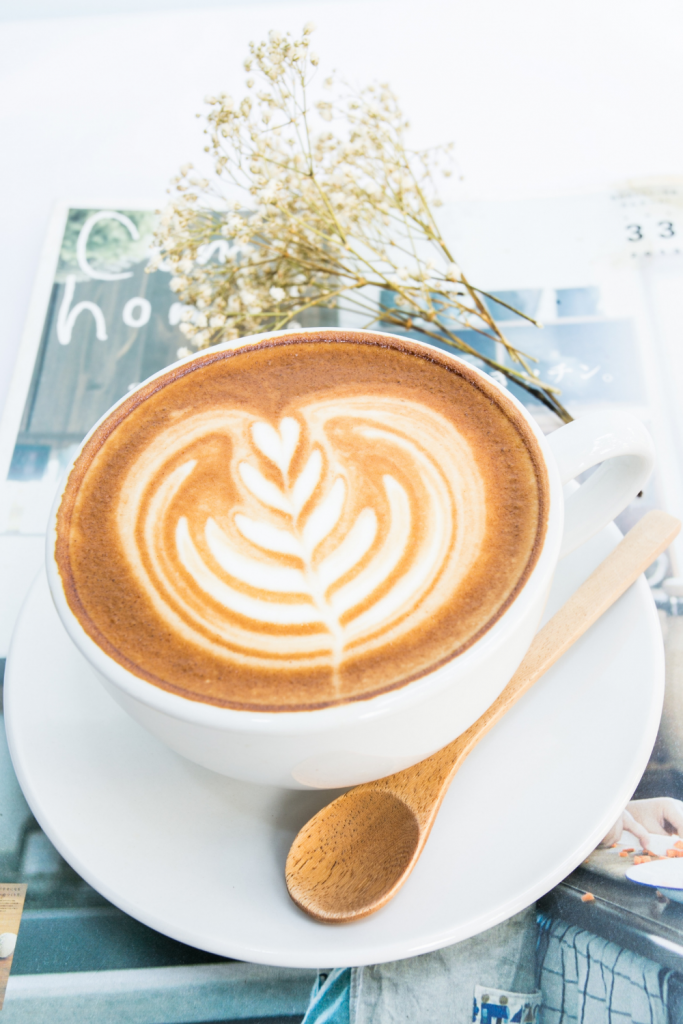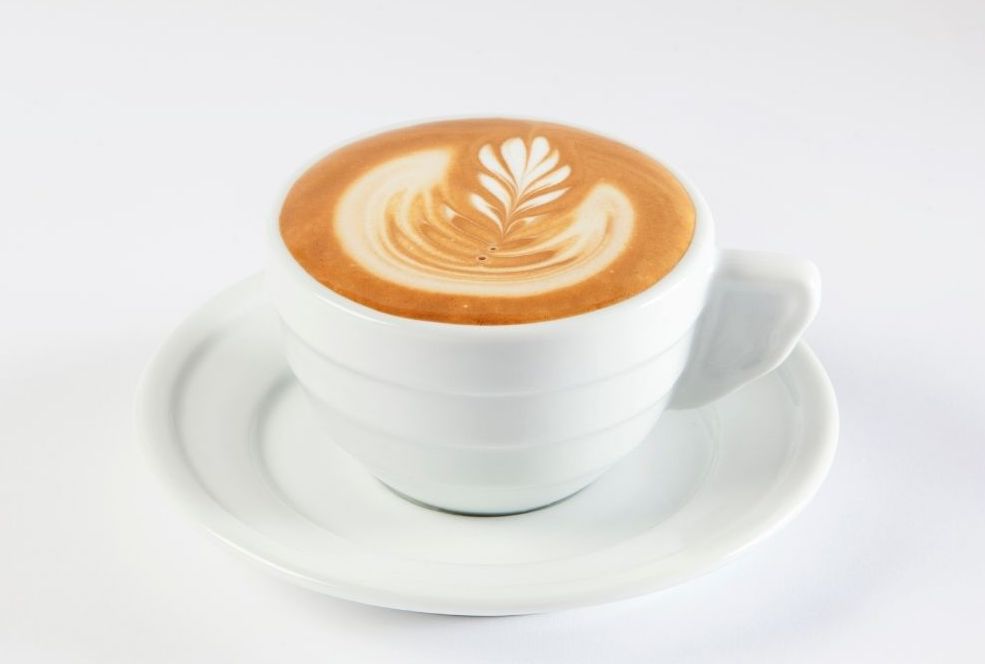The Flat White hasn’t been around long, especially in North America. And it certainly doesn’t replace the centuries-old cappuccino. But it does offer something new for coffee enthusiasts!
I’ve been serving up these drinks for years and would recommend either. Especially if you’re looking for the full flavor of an espresso doppio softened by the creamy sweetness of milk.
The truth is that flat white and cappuccino differ very little in how they’re prepared and served. So why choose one over the other? The subtle contrast lies in their texture, mouthfeel, and flavor.

What is a Cappuccino?
A cappuccino is a 6-ounce drink made with steamed milk and espresso.
Compared with other espresso-milk drinks, this one has more air bubbles worked into the milk. This brings a cappuccino lightness that you just don’t get with lattes and other drinks.
For years, cappuccinos were served layered, with stiff foam scooped atop milky espresso. Today, the trend is to err more on the “wet” side so that the espresso and foamy steamed milk are more seamlessly combined.

The cappuccino is traditionally the “foamiest” of the classic espresso drinks. Hence the terms “wet” and “dry” many used to dictate their preferred ratio of foam to coffee.
What is a Flat White?
A flat white is a 6-ounce drink made with steamed milk and espresso.
Like the cappuccino, a flat white should be one-third espresso and two-thirds steamed milk.
Unlike a cappuccino, a flat white is made with little to no foam. This gives the finished product a “flat,” creamy appearance.

Yes, the difference is subtle. Even so, I’ve found that most people tend to strongly prefer one drink or the other. Let’s take a closer look at why.
Key Differences Between Flat White & Cappuccino
Presentation
Your local barista will often pour your flat white or cappuccino into a 6-ounce ceramic cup. Some like to sprinkle chocolate powder or cinnamon on top of their cappuccinos.
But if your barista did you right, you needn’t worry about toppings or sweeteners. The coffee and milk should speak for themselves.
Taste and Texture
A barista produces milk froth and foam by aerating milk with a steam wand.
Hence, a flat white is less aerated to produce as little foam as possible. This results in a thicker mouthfeel and a creamier experience of espresso.
The cappuccino is prepared with a higher level of foam. This gives it a lighter mouthfeel because there is literally more air in the milk.

While both drinks are naturally sweet and creamy, espresso flavors are more likely to pop in a cappuccino. This is due to more air in the milk for those coffee flavors to travel through.
Size and Strength
Both flat whites and cappuccinos are traditionally served with a double shot of espresso. No more, no less. Then the barista adds 4 ounces of milk to create a 6-ounce drink.
The traditional approach isn’t always what you’ll find at the cafe. The truth is that some shops take extreme creative license with their cappuccino.
I’ve found a 20-ounce “cappuccino” on one menu. While other cafes only offer water in a cup that large.
Both drinks can attribute much of their flavor characteristics to the serving size. Or, more specifically, the ratio of espresso to milk used during preparation.
My take: If you find either of these drinks listed at larger than 6 ounces, you’re actually getting a latte.
Milk Froth
The rise of third-wave coffee resulted in big changes for the cappuccino.
Many baristas stopped serving cappuccinos with a dollop of stiff foam added to the top. Instead, many began experimenting with ways to make the cappuccino taste less compartmentalized.
What do I mean by “compartmentalized?” Think “face-full” of foam, followed by slightly milky espresso.
These days, the “wet” cappuccino has taken over.
Not only does the “wet” style allow the espresso and milk to blend for a more flavorful cup. It also allows baristas to pour latte art. This is an impossible feat when milk foam is fluffy and stiff.

The rise of the wet-cap doesn’t stop cappuccino lovers from ordering a dry cappuccino – and it shouldn’t.
Preparation
Creating foam or “aerating” milk occurs in two steps.
After adding 4-5 ounces of milk to their milk pitcher, a barista fully submerges their steam wand. This creates a gentle swirl, which heats and aerates the milk evenly.
Next, the barista creates foam. To accomplish this, the tip of the steam wand slowly lifts to the surface of the milk. The right amount of air gets pushed into the milk through quick, successive exposures.
How does a flat white stay so flat?

A barista will aerate the milk as little as possible. This means less foam and gives the drink a “flat” appearance.
For a cappuccino, the barista takes a different approach. A longer time is allocated for aerating the surface of the milk. This results in a soft, foamy texture.
A barista may slam their pitcher onto the counter after steaming their milk. This is not for show.
Knocking the base of the milk pitcher is a great way to eliminate accidental oversized bubbles. These often form during the aeration process. Fewer bubbles make a better environment for the barista to pour latte art and create a tastier texture.
Origins
There’s a bit of controversy over the specific origins of the flat white. We know it originated in either New Zealand or Australia in 1985 or 1989.
The New Zealand version of events comes from former barista Frank McInnes. He claims he invented the flat white when he served a customer a poor excuse for a cappuccino and apologized for his “flat white.”
Former barista and cafe owner Alan Preston claims he invented the flat white. His version says the drink originated in his Sydney cafe in 1985. He even built a website to promote his narrative with photographic evidence.
Either way, we’re happy to let the flat white grace our palettes in cafes worldwide.
The cappuccino’s history is far more straightforward. It was first served in Austria and later popularized in Italy. Most people believe the name “cappuccino” refers to the color of the Italian monk’s robes, which were light brown at the time.
FAQs
Both drinks are served with a double shot of espresso, so the caffeine level will vary slightly between drinks. If you want your drink to pack more punch, a triple cappuccino is not half bad.
Both drinks are traditionally defined by their size and levels of foam. Neither of these beverages directly translates to “iced.” However, this hasn’t stopped creative baristas from serving iced lattes with cold foam on top and calling them iced cappuccinos. Or serving iced lattes in a smaller size to emulate the flat white’s milk-to-coffee ratio to create an iced flat white.
Want weekly coffee tips and tricks, recipes and more?
Put your email in the box below and you’ll not only get added to our list but you’ll also get 3 free recipe cards (Colada Coffee, Mocha and Spanish Latte) delivered right to your inbox!
